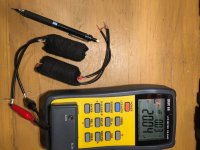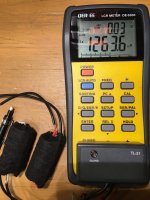Yes... that was kinda the point.seems you got the lyrics wrong
Hello Hierfi,
I am attempting to keep the thread on track. There is no end to chaff in this thread, and that has killed so many excellent threads in the past, the main message and information gets lost. That is such a shame.
Mark and I communicating is none of your business, and anything from that would have messed up the thread. I do respect Mark and his viewpoint. It's the same as many other members communicating off-line. That isn't anyone else's business.
I'm not the only other member who has attempted to correct bad information or bring the focus back on the topic. I've been fulfilling this function for about 19 years now, 20 if you count my time before being a moderator. Now if you suggest that there ought not to be a test for what people post, run on over to AudioKarma and have a look around. It is a waste of my time to be honest, however the truth is very simple. If bad information isn't pointed out and called into question, it becomes the truth. The internet has been the worst place for this because anyone can post anything under the guise of "freedom of speech". However, I think we also have to be honest and responsible about what is posted. They are discussing this concept for the internet currently as it is a recognised problem. Do not be a part of the problem.
Now if you were to say it is your opinion that electrolytics that are purple and installed backwards sound better, great. However you have to include this is only your opinion, or it becomes misinformation (wording this as nicely as I can). Several folks here are posting from direct personal experience in this field, and with verifiable testing. It is actually the real, physical truth. What I have seen over the years is that people want to be included in this discussion and "be someone" I guess. But they lack the training, equipment and real experience to have an informed opinion. They still want to play, so they intrude with hearsay and uncontrolled experimental results without a wide enough dataset.
I can be wrong, and you'll notice when I am, I admit it and thank the person who corrects me. My training killed ego, reality is brutal for people with thin skins.
I am attempting to keep the thread on track. There is no end to chaff in this thread, and that has killed so many excellent threads in the past, the main message and information gets lost. That is such a shame.
Mark and I communicating is none of your business, and anything from that would have messed up the thread. I do respect Mark and his viewpoint. It's the same as many other members communicating off-line. That isn't anyone else's business.
I'm not the only other member who has attempted to correct bad information or bring the focus back on the topic. I've been fulfilling this function for about 19 years now, 20 if you count my time before being a moderator. Now if you suggest that there ought not to be a test for what people post, run on over to AudioKarma and have a look around. It is a waste of my time to be honest, however the truth is very simple. If bad information isn't pointed out and called into question, it becomes the truth. The internet has been the worst place for this because anyone can post anything under the guise of "freedom of speech". However, I think we also have to be honest and responsible about what is posted. They are discussing this concept for the internet currently as it is a recognised problem. Do not be a part of the problem.
Now if you were to say it is your opinion that electrolytics that are purple and installed backwards sound better, great. However you have to include this is only your opinion, or it becomes misinformation (wording this as nicely as I can). Several folks here are posting from direct personal experience in this field, and with verifiable testing. It is actually the real, physical truth. What I have seen over the years is that people want to be included in this discussion and "be someone" I guess. But they lack the training, equipment and real experience to have an informed opinion. They still want to play, so they intrude with hearsay and uncontrolled experimental results without a wide enough dataset.
I can be wrong, and you'll notice when I am, I admit it and thank the person who corrects me. My training killed ego, reality is brutal for people with thin skins.
"Now if you were to say it is your opinion that electrolytics that are purple and installed backwards sound better, great. However you have to include this is only your opinion"
I am colour blind and thought a red terminal on a capacitor was black, so I connected the capacitor in my power amplifier power supply the wrong way round. It factually blew... in my opinion.
I am colour blind and thought a red terminal on a capacitor was black, so I connected the capacitor in my power amplifier power supply the wrong way round. It factually blew... in my opinion.
Maybe instead of it having blew, it redded. lol! Sorry ...
Colour blindness is no joke, sorry you have that issue. Early we learned to listen for the "pre hiss" just before a capacitor exploded. You hit the dirt quickly and sometimes not near quick enough. It is very dangerous. More than once a tech has filled the air with paper fuzz and a can travelling quickly.
It is fairly easy to install a capacitor (or anything) backwards. If you are rushing, well there is #1. PCBs marked incorrectly, incorrect service manuals. Even original parts marked in a way that didn't follow convention. I just worked on a unit where many capacitors had a band on the positive side (with + symbols). I nearly installed a bunch backwards. By the way, I don't "recap" equipment blindly, that is a very bad idea.
Colour blindness is no joke, sorry you have that issue. Early we learned to listen for the "pre hiss" just before a capacitor exploded. You hit the dirt quickly and sometimes not near quick enough. It is very dangerous. More than once a tech has filled the air with paper fuzz and a can travelling quickly.
It is fairly easy to install a capacitor (or anything) backwards. If you are rushing, well there is #1. PCBs marked incorrectly, incorrect service manuals. Even original parts marked in a way that didn't follow convention. I just worked on a unit where many capacitors had a band on the positive side (with + symbols). I nearly installed a bunch backwards. By the way, I don't "recap" equipment blindly, that is a very bad idea.
I think anyone could accept your opinion. Did the "bang" have the right sound quality? Proof would be blown seals and a capacitor that occupies greater volume than they do before installation. Paper fuzz is pretty convincing proof too.It factually blew... in my opinion.
Exploding capacitors smell nowhere near as good as burning resistors ... in my subjective opinion.
Tom
Tom
Oh, back on topic.
I can recommend hybrid polymer capacitors by Panasonic. They explode without smoke or smell. Just very loud bang.

Hmm. Now I wonder whether dielectric absorption has introduced distortion in explosion sound? 🤔
I can recommend hybrid polymer capacitors by Panasonic. They explode without smoke or smell. Just very loud bang.
Hmm. Now I wonder whether dielectric absorption has introduced distortion in explosion sound? 🤔
I’ll second that 🤣🤣🤣Exploding capacitors smell nowhere near as good as burning resistors ... in my subjective opinion.
Tom
Yes, and just had cataract surgery done on both eyes in the past month. Now I can clearly not see colour.Colour blindness is no joke, sorry you have that issue.
Last edited:
Well, now you've done it... going to start a flame war over the subtleties of carbon comp vs metal film. Although anyone with taste, of course, prefers the delicate and expensive bouquet of metal foil 🤓Exploding capacitors smell nowhere near as good as burning resistors ... in my subjective opinion.
Where's the fun in that?! You should get your money back!They explode without smoke or smell. Just very loud bang.
Tom
Nothing like a sip of hot carbon-composition roast coffee to get one going in the morning...AHH...
I guess I got hooked on CC from building that KT88 amp...but will still drink some MF if offered... 🍮
Well anyway...here is an audio-circuit example where the capacitor distortion problem presents itself:

This is from an Mc-712 that I gutted and rebuilt a few years ago. This is one of the tone sub-circuits that I retained with slightly altered component values and trace pathways. C12 is an electrolytic. Shriek! 😉
The 22uF fella runs afoul of Self's admonition about cut-off frequencies and distortion. The problem is, the value is fixed for a given filter response.
(Yes, I prefer the gyrator response curve, rather than the shelved response curve, for adjusting the various rogue EQ'ed recordings I have.)
So, at that time, I prepared a (relatively large) poly-pro replacement for the electrolytic, and shielded it with copper tape, since I was paranoid about turning this circuit into RF fly-paper.
Both cable shields are soldered to the Cu foil surrounding the capacitor.
Here is the capacitance measurement :


here is the inductance measurement :


This capacitor creation has not been installed, since the pre-amplifier sounds very clear to me now, and I do not think, based on previous personal experiments, as well as other reported information, that I will notice any increase in clarity or enjoyment. ( What? Biased predetermined outcomes...? Yes. )
My motivation to rip-open the preamp carcass is small relative to other projects...
While I have a nice hobbyist bench, I do not have any distortion measuring capability at this time. My background is in the Automation and Systems Control design side of things, so while I can understand most discussions, my knowledge is shallow in most electronics.
For the fun of discussion, what are some solutions to the gyrator capacitor distortion issue presented? SWAG, do nothing, or otherwise?
Capacitor discussions:

David
I guess I got hooked on CC from building that KT88 amp...but will still drink some MF if offered... 🍮
Well anyway...here is an audio-circuit example where the capacitor distortion problem presents itself:
This is from an Mc-712 that I gutted and rebuilt a few years ago. This is one of the tone sub-circuits that I retained with slightly altered component values and trace pathways. C12 is an electrolytic. Shriek! 😉
The 22uF fella runs afoul of Self's admonition about cut-off frequencies and distortion. The problem is, the value is fixed for a given filter response.
(Yes, I prefer the gyrator response curve, rather than the shelved response curve, for adjusting the various rogue EQ'ed recordings I have.)
So, at that time, I prepared a (relatively large) poly-pro replacement for the electrolytic, and shielded it with copper tape, since I was paranoid about turning this circuit into RF fly-paper.
Both cable shields are soldered to the Cu foil surrounding the capacitor.
Here is the capacitance measurement :


here is the inductance measurement :


This capacitor creation has not been installed, since the pre-amplifier sounds very clear to me now, and I do not think, based on previous personal experiments, as well as other reported information, that I will notice any increase in clarity or enjoyment. ( What? Biased predetermined outcomes...? Yes. )
My motivation to rip-open the preamp carcass is small relative to other projects...
While I have a nice hobbyist bench, I do not have any distortion measuring capability at this time. My background is in the Automation and Systems Control design side of things, so while I can understand most discussions, my knowledge is shallow in most electronics.
For the fun of discussion, what are some solutions to the gyrator capacitor distortion issue presented? SWAG, do nothing, or otherwise?
Capacitor discussions:
David
Does that also work in listening for the "pre hiss" when you put your fingers across the high voltage supply of tube amplifier?Early we learned to listen for the "pre hiss" just before a capacitor exploded.
At least bull riding is capped at 8 seconds... 🙂Capacitor discussions:

Tom
This is not the way knowledgeable people approach a tube amplifier.
I know... and I thought I was one of the knowledgeable people..!.
Before retiring I was the supervisor of the Electronics Shop in Electrical Engineering at Western University. In my spare time I built numerous autonomous robots for competition at APEC conventions in the US, being financially sponsored to attend after my first year by the organizer and dominant competitor in the US a David Otten, a Principal Research Engineer, Research Laboratory of Electronics at MIT. After I poked myself I thought about returning my Award of Merit presented to me by the president of the local chapter of the IEEE for "outstanding engineering competence in the design of a micromouse".
Make one little mistake and you become an ignorant person again... life is not fair.
Not everything written here is intended as a personal attack. Just saying... In fact, nothing here should be intended as a personal attack. Also keep in mind that posts written hours ago might be interpreted differently than intended once received.
Hopefully we can agree that sticking your fingers across high voltage is not exactly the smartest move. But then again, maybe your post about that wasn't intended to be taken literally.
Tom
Hopefully we can agree that sticking your fingers across high voltage is not exactly the smartest move. But then again, maybe your post about that wasn't intended to be taken literally.
Tom
Absolutely Tom... and accidents do happen when you become complacent or thoughtless for a moment, as did and got rewarded for it, and as likely you can understand.
It was taken in consideration as you said "as not a personal attack". However it can also be perceived by others reading it that it was. That was taken in consideration as well.
It was taken in consideration as you said "as not a personal attack". However it can also be perceived by others reading it that it was. That was taken in consideration as well.
Last edited:
Yep. Accidents can happen even when you're being careful. One time in college I was working on a switch mode power supply that plugged into the mains, so I had about 415 V across the main supply cap. I always made sure to measure if that cap had discharged to a safe level before modifying the circuit. Well... One time I forgot to turn the supply off, so the full voltage was present across that cap when I measured it. It was then I learned that the probe leads we had in college had the exposed metal of a banana plug connected to the probe tip that would rest perfectly in my hands between the thumb and index finger. 415 V across the chest certainly threw me back in the chair.
Tom
Tom
- Home
- Amplifiers
- Solid State
- Würth Elektronik ANP125 - Capacitors don’t cause any appreciable signal distortion
